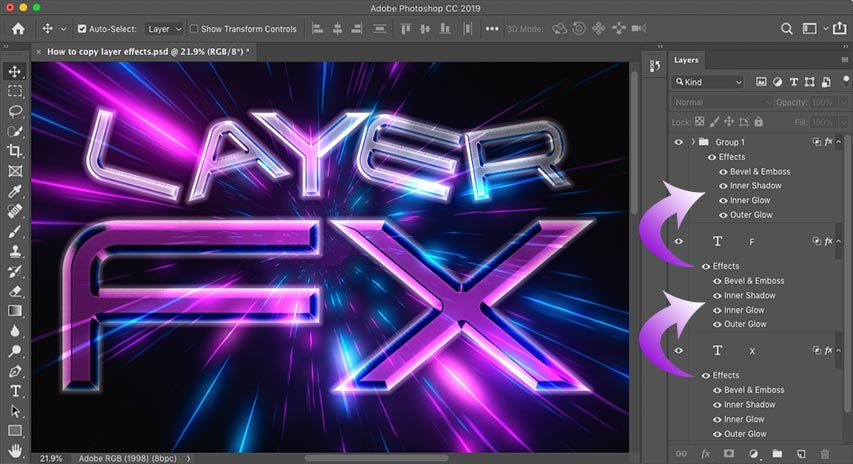Mastering Efficiency: A Comprehensive Guide on How to Copy Layer Effects in Photoshop

Introduction:
Adobe Photoshop, a powerhouse in digital design, provides a wealth of tools and features to bring creative visions to life. Among these, layer effects play a pivotal role in adding depth, texture, and stylistic elements to your compositions. To streamline your workflow and ensure consistency across layers, mastering the art of copying layer effects is essential. In this comprehensive guide, we will delve into the various techniques and methods to efficiently copy layer effects in Photoshop, empowering you to elevate your designs with precision and ease.
Understanding Layer Effects in Photoshop:
- Versatility of Layer Effects: Layer effects in Photoshop encompass a range of features, including shadows, glows, gradients, and more. These effects contribute to the overall visual appeal and aesthetic coherence of your designs.
- Efficiency in Design Workflow: As you work on complex projects with multiple layers, copying layer effects becomes a time-saving strategy. It ensures that consistent styles are applied across various elements, maintaining a cohesive and professional look.
Methods for Copying Layer Effects:
Note: Before copying layer effects, ensure that the layers involved have compatible attributes and properties.
- Using the Copy-Paste Method:
a. Select the Source Layer: Choose the layer from which you want to copy the effects. Click on the layer in the Layers panel to make it active.
b. Access Layer Styles: Right-click on the source layer or go to the “Layer” menu, then select “Layer Style.” Choose “Copy Layer Style” from the context menu.
c. Apply to Target Layer: Switch to the target layer where you want to apply the copied effects. Right-click on the target layer or go to the “Layer” menu, then select “Layer Style” > “Paste Layer Style.”
d. Adjust as Needed: Fine-tune the applied layer effects on the target layer by accessing the Layer Style options. Right-click on the target layer and choose “Blending Options” to make adjustments.
- Dragging Layer Effects:
a. Select the Source Layer: Similar to the copy-paste method, select the source layer by clicking on it in the Layers panel.
b. Drag Effects Icon: In the Layers panel, locate the “fx” icon, representing layer effects, next to the selected layer. Click and drag this icon onto the target layer where you want to apply the effects.
c. Drop onto Target Layer: Release the mouse button to drop the effects onto the target layer. Photoshop will apply the copied layer effects to the destination layer.
d. Adjust as Needed: Refine the effects on the target layer by accessing the Layer Style options, allowing you to customize parameters based on your design requirements.
Copying Multiple Layer Effects:
- Copy All Effects at Once: To copy all layer effects from a source layer to a target layer simultaneously, use the copy-paste or drag-and-drop method described above. This ensures a cohesive transfer of all applied effects.
- Copying Specific Effects: For more granular control, you can copy specific layer effects individually. In the Layer Style dialog box, uncheck the effects you don’t want to copy, ensuring only the desired effects are applied to the target layer.
Utilizing the Copy Merged Option:
- Merge Visible Layers: If you have multiple layers with distinct effects and want to apply a consolidated set of effects to another layer, use the “Copy Merged” option.
- Select Visible Layers: Hold down the Shift key and click on the eye icon next to the layers you want to include in the merge. This selects all visible layers.
- Copy Merged: With the visible layers selected, right-click and choose “Copy Merged.” Paste this merged copy onto the target layer and adjust the layer effects as needed.
Advanced Techniques for Efficiency:
- Creating Layer Style Presets: To enhance efficiency, consider creating layer style presets. After customizing layer effects on a layer, click the “New Style” button in the Layer Style dialog box. This allows you to reuse the preset on other layers.
- Using Adjustment Layers for Global Effects: For global adjustments affecting multiple layers, utilize adjustment layers. Apply effects like Gradient Overlay or Color Overlay as adjustment layers, ensuring changes are reflected across multiple layers simultaneously.
Troubleshooting and Considerations:
- Layer Compatibility: Ensure that the source and target layers are compatible in terms of content and properties. For instance, certain effects may not work as expected on text layers versus shape layers.
- Rasterizing Smart Objects: If you encounter issues copying layer effects to or from smart objects, consider rasterizing the smart object to simplify the layer structure and enable seamless effect transfer.
- Adjusting for Layer Position: Keep in mind that layer effects are position-dependent. If you copy effects to a layer with a different position, you may need to readjust effects like shadows and glows to align with the new layer position.
Conclusion:
Efficiently copying layer effects in Photoshop is a skill that enhances your ability to maintain consistency and professionalism in your designs. Whether you’re working on intricate digital art, web design, or photo manipulation, the ability to transfer and adapt layer effects streamlines your creative process. As you incorporate these techniques into your workflow, you’ll find that the synergy between design precision and time-saving strategies elevates your proficiency in leveraging Photoshop’s expansive toolkit. So, embark on your design journey with confidence, armed with the knowledge to effortlessly copy layer effects and sculpt your digital masterpieces with finesse.






